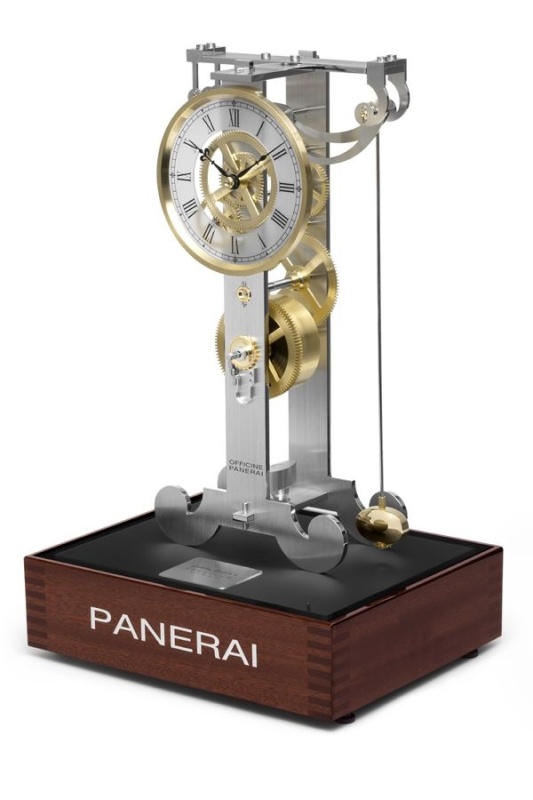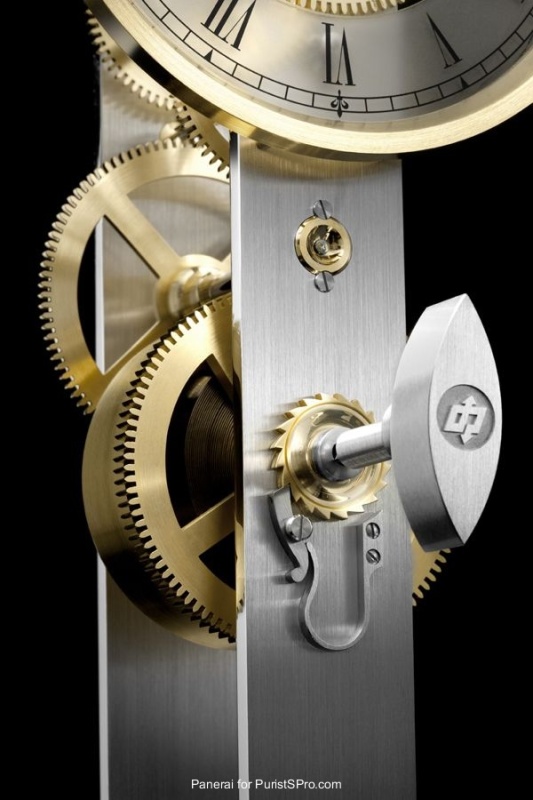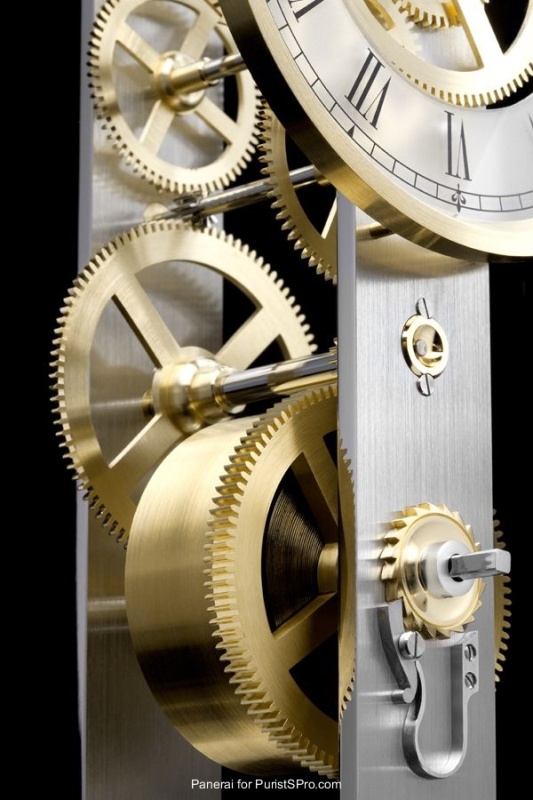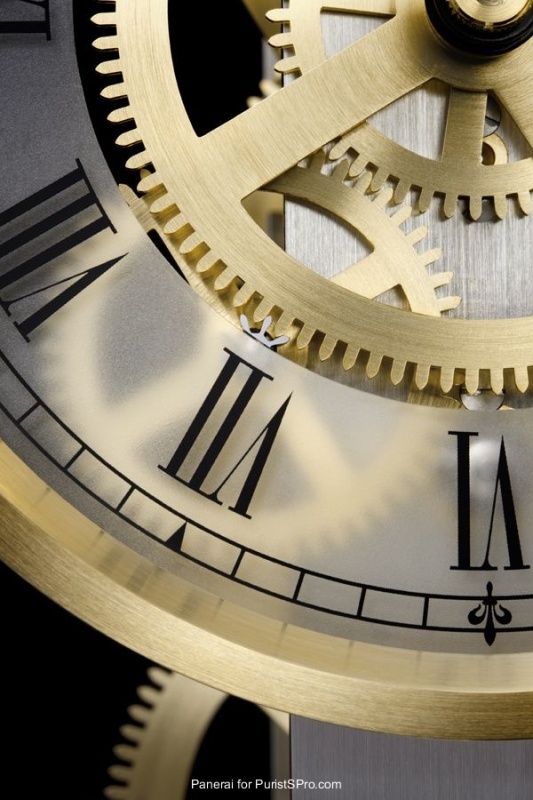
AnthonyTsai
[PuristS]
22937

SIHH 2014: Panerai PAM500 GALILEO GALILEI’S PENDULUM CLOCK
Panerai makes another complicated clock - this time called the Panerai Pendulum Clock PAM500 which is made in 30 units and only sold at Panerai Boutiques.

Below is the full press release.
Cheers,
Anthony
The pendulum of Galileo Galilei, the “measurer of time” which marked a turning point in horology because it opened the doors of the modern era, now beats again thanks to Officine Panerai and its new Pendulum Clock. This is a faithful reproduction of the instrument designed by Galileo to demonstrate that the law of isochronism of small oscillations of the pendulum – the period of oscillation of pendulums of equal length is constant regardless of the amplitude of oscillation – could be applied to the measurement of time. Galileo’s discovery in the 17th century represented a real revolution, because it enabled clocks to progress from an error of several minutes per day to one of just a few seconds. The escape wheel designed by the Tuscan scientist is recognised as the first free escapement in history and the Pendulum Clock therefore represents an operation of exceptional historic importance and technical mastery, underlining once again the link between Galileo, Florence, Science and Officine Panerai.
The application of the pendulum to timekeeping is a long and painful story: Galileo could notdevelop his intuition of 1641 since he was by then almost blind, so its realisation was entrustedto his son Vincenzo. Galileo died in the following year and the project lay dormant for a long timeuntil, in 1649, his son decided to complete it. A blacksmith made the iron frame and the wheelsand pinions in their crude state while Vincenzo Galilei himself cut the teeth of the escapement.Unfortunately he too died a few months later and the model, still incomplete but probablyoperational, remained in oblivion for some time.
It was in 1659 that Vincenzo Viviani, friend and biographer of Galileo, recovered the model at therequest of Leopoldo de’ Medici and brought it to the Florentine prince together with a drawing.And it is only the latter which survives, because all trace of the machine itself has been lost: thedrawing now preserved in Florence illustrates the structure and the principle of operation of thisinstrument which gave physical form to the intuition which Galileo had had years earlier and to theformulation of the laws of isochronism.
The Pendulum Clock is based on the model made by the Florentine clockmaker EustachioPorcellotti in 1887 from this original drawing, a model which is now preserved in the Museo Galileoin Florence. The winding system and the dial are not shown in the drawing. Galileo believed thatisochronism had resolved all the defects of clocks: this was the fundamental point of his discovery,and he was therefore not concerned with what type of motive power should be used or withthe design of the dial. For him these were secondary details, which, however, may have beenhinted at in the model shown to Prince Leopoldo de’ Medici because a writing by Vincenzo Vivianimentions a “clock of iron, unfinished, with pendulum, Galileo’s first invention”. Porcellotti addedboth a barrel with the mainspring and a dial with Roman numerals to his model, thus completingthe instrument by indicating hours and minutes.
The remarkable new Officine Panerai production interprets Porcellotti’s work almost exactly.The height of the Pendulum Clock is 35.6 cm, the width 18.5 cm and the depth 11.1 cm: thedimensions of this table clock are taken from the original drawing and they are confirmed by thefew other reliable reconstructions. The frame consists of two main plates, which are made not ofiron, as in the original model and Porcellotti’s, but of brass, plated with nickel-palladium, and theyare joined by crosspieces at the top and the bottom fixed in the traditional way by taper pins. Theupper crosspiece carries the escapement and the pendulum suspension, while the lower oneconnects the lower parts of the frame plates which are formed into four scrolled feet. Betweenthe base and the dial is the spring barrel, the drum of which contains a spring 4.10 metres longwhich powers the clock for eight days. The clock is wound by turning the square winding arborwith a key, while a ratchet with its related spring is mounted above the centre of the spring barrelto prevent it unwinding. Higher up is the dial with Roman numerals, like that of the 1887 model, withblack-lacquered hands. The wheels with their hand-finished teeth, the bezel surrounding the dial,the spring barrel and other details are all gold plated.
The fundamental part of the clock is the regulating pendulum and escapement designed byGalileo. This consists of an escape wheel with 12 pins fitted to its side and 12 teeth cut in itsperimeter, and three levers, one on the left as you look at the clock and two on the right. Theone on the left, the longest lever which ends with a hook, is the stopping lever; the two on theright, arranged like scissors, are the release and impulse levers. While the wheel is in its stoppedphase, the pendulum is completely free from any contact with it, and for this reason the device iscalled a “free escapement”. The pendulum itself consists of a rod terminating with a gold platedovoid lenticular bob, with the screw for adjusting the period of oscillation below it. On the lowercrosspiece is a place for keeping the key for winding the clock.
The Pendulum Clock is mounted on a mahogany base, with a hinged plate on the front on whichthe name of the model is engraved; underneath the plate is a bubble level, indispensable since theclock must be perfectly horizontal to run accurately. The base is levelled by turning the four adjustablefeet of the wooden base. Completing the Pendulum Clock is a glass case, with a black-lacqueredaluminium frame and a door at the front enabling the clock to be wound and its hands to be set.
The Panerai Pendulum Clock is made in 30 numbered units, sold only in the Officine Panerai boutiques around the world.













This message has been edited by AnthonyTsai on 2014-01-20 08:25:44
